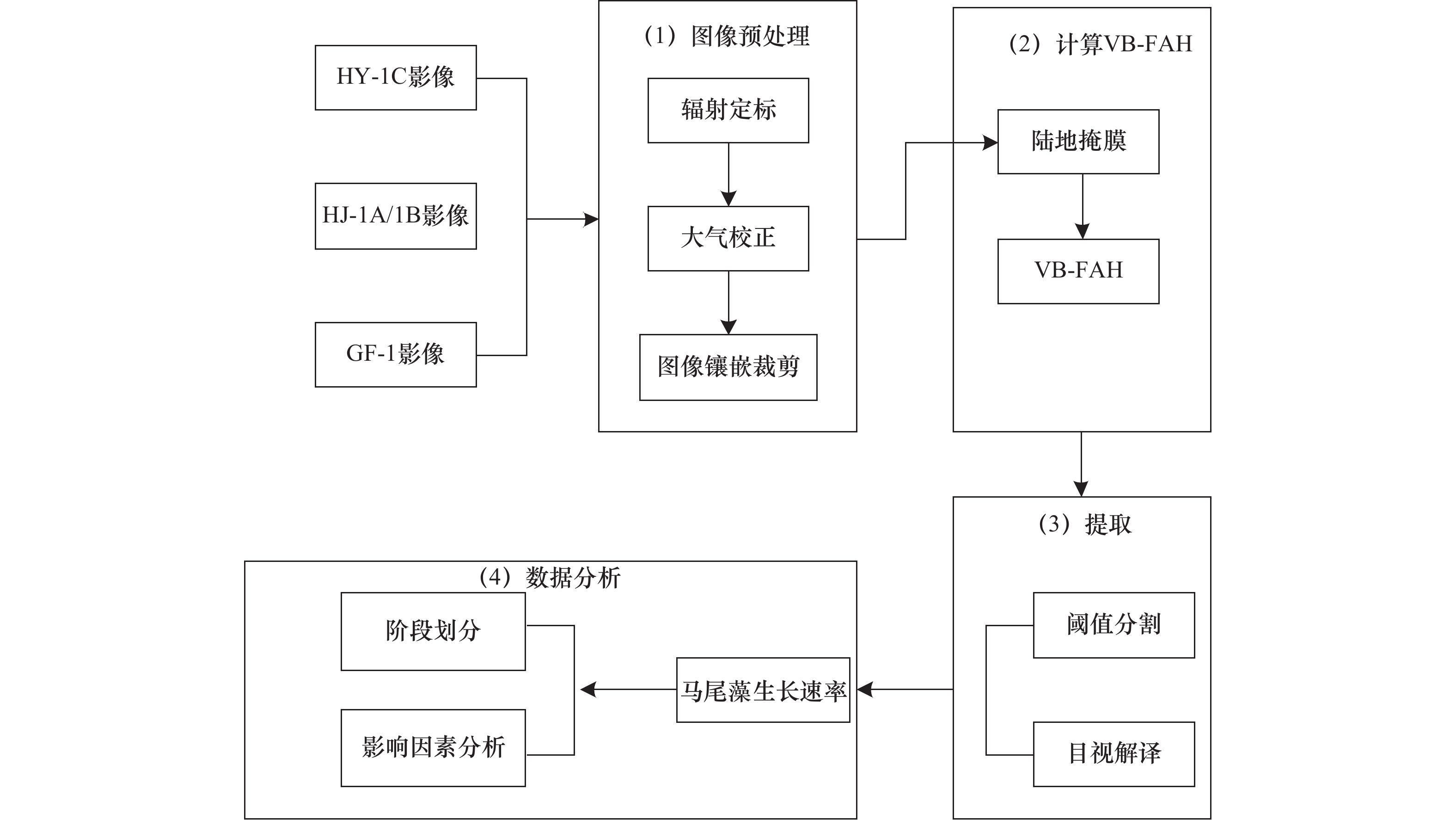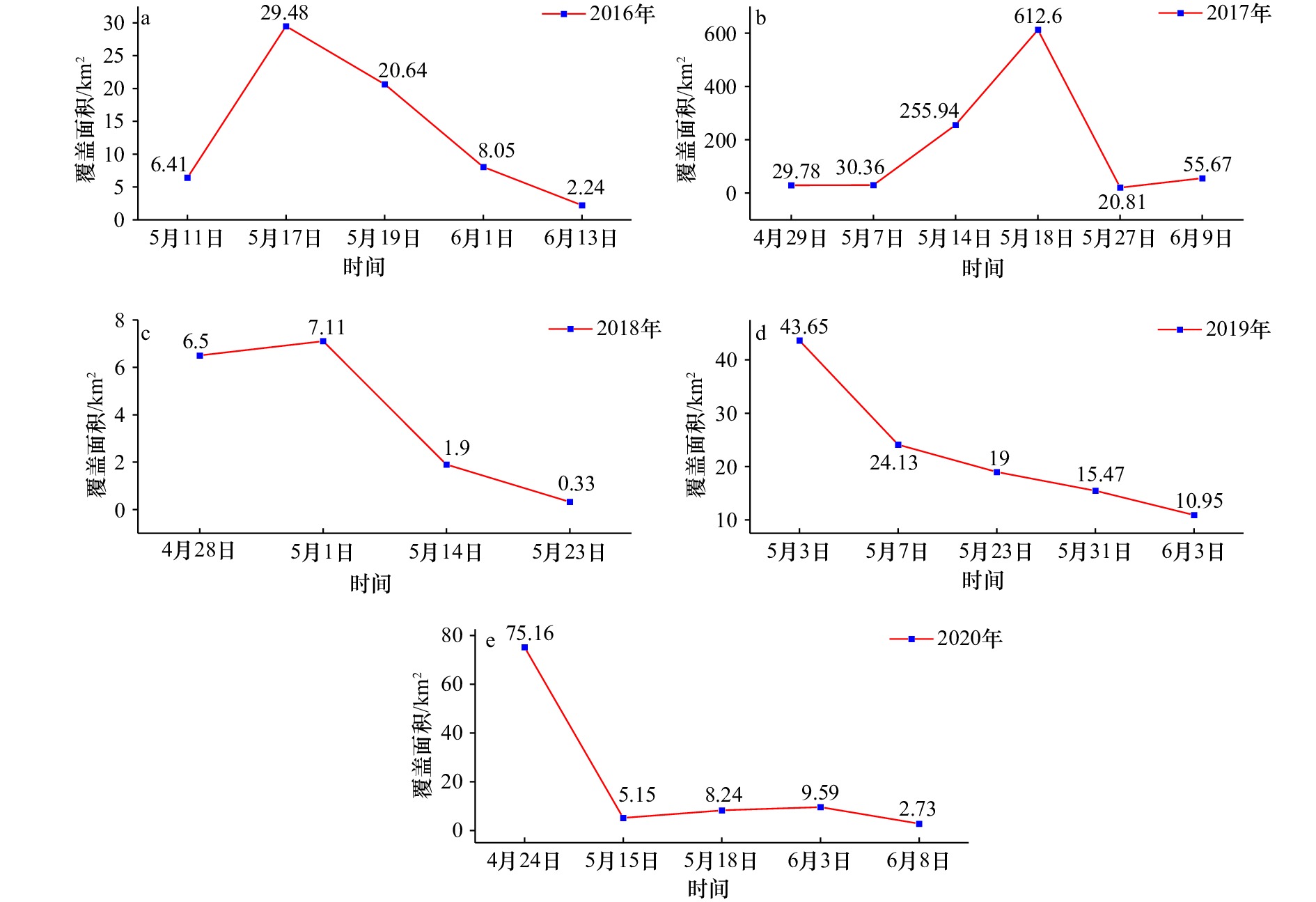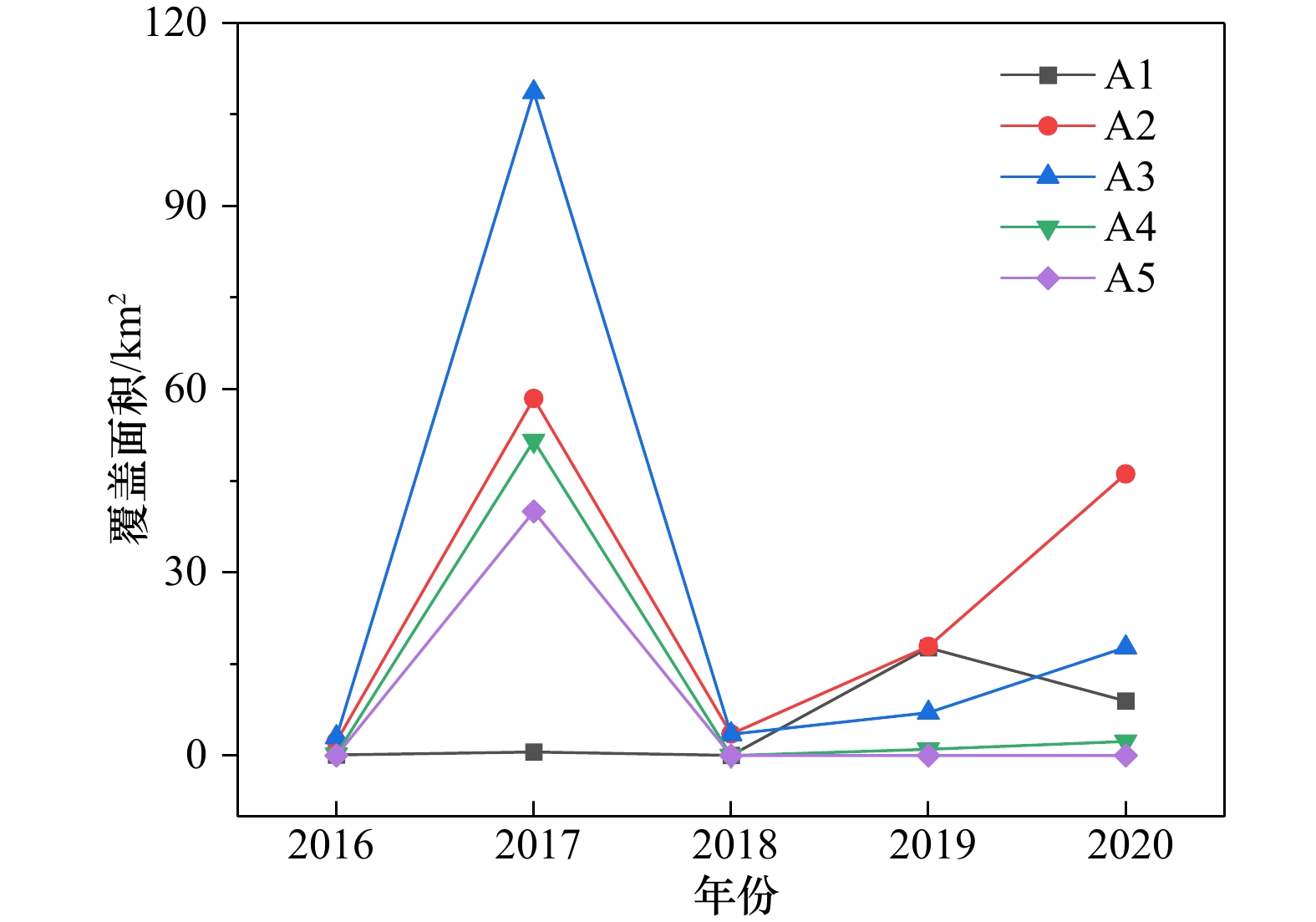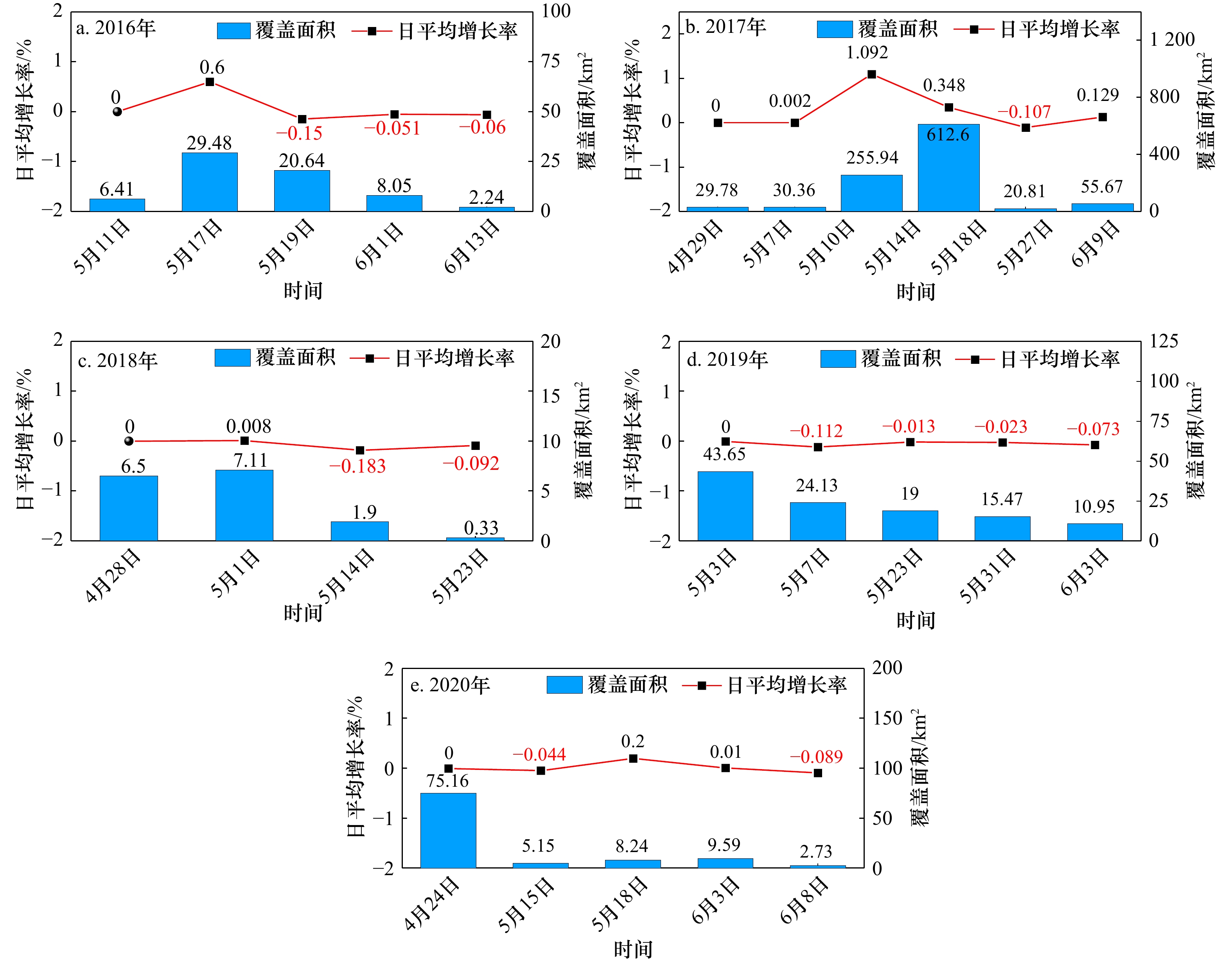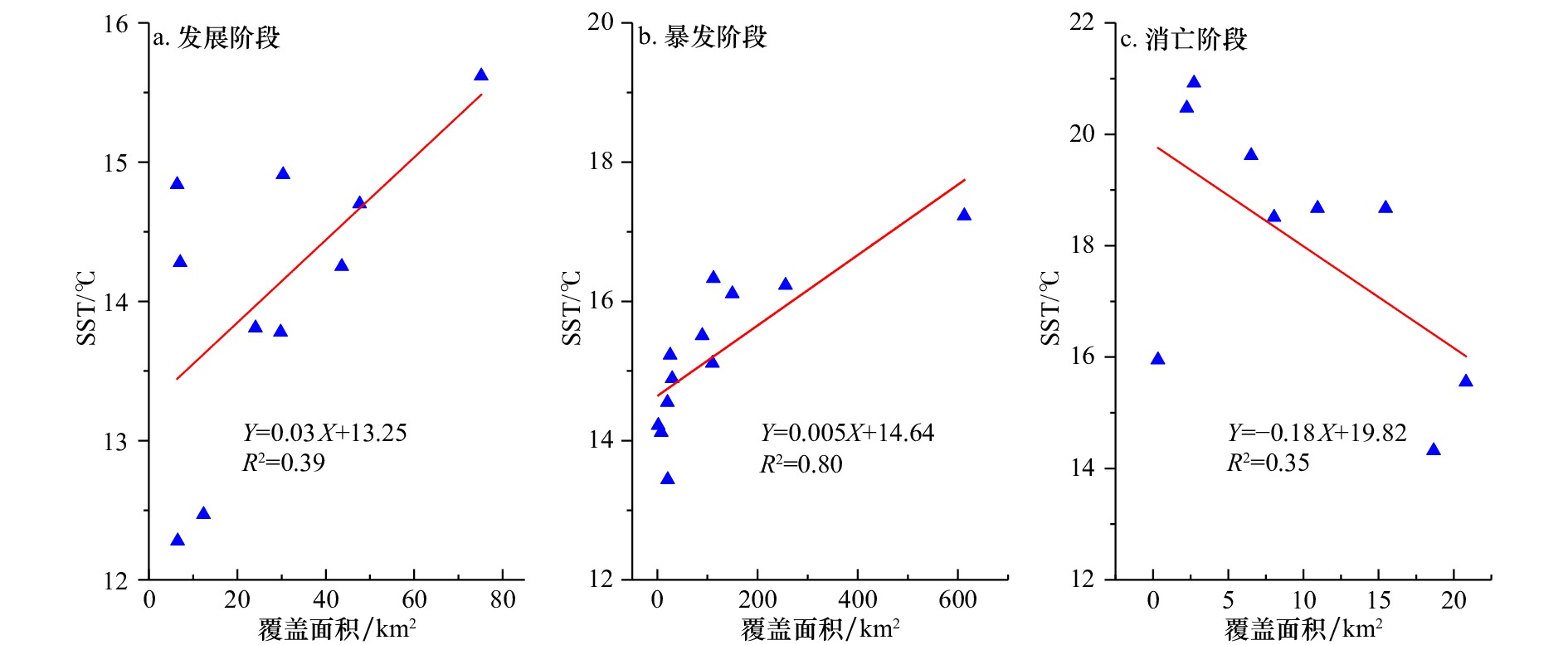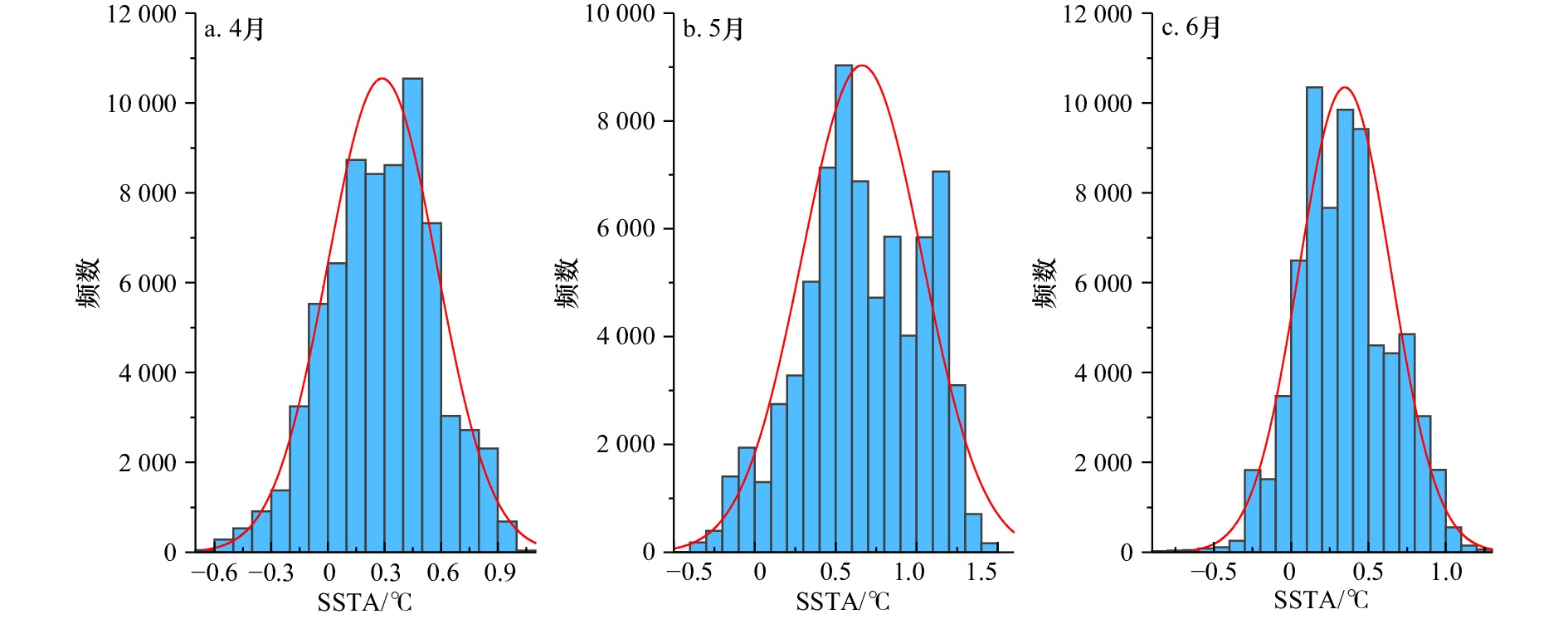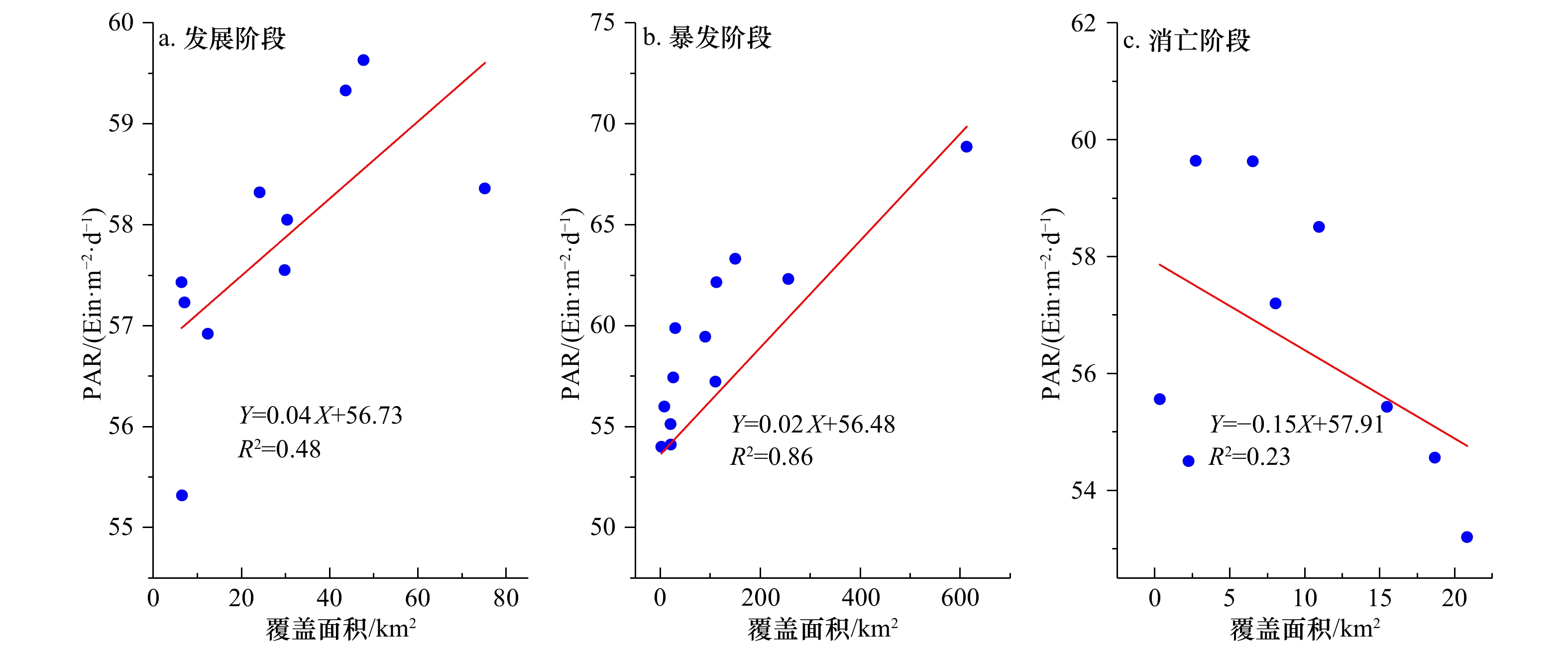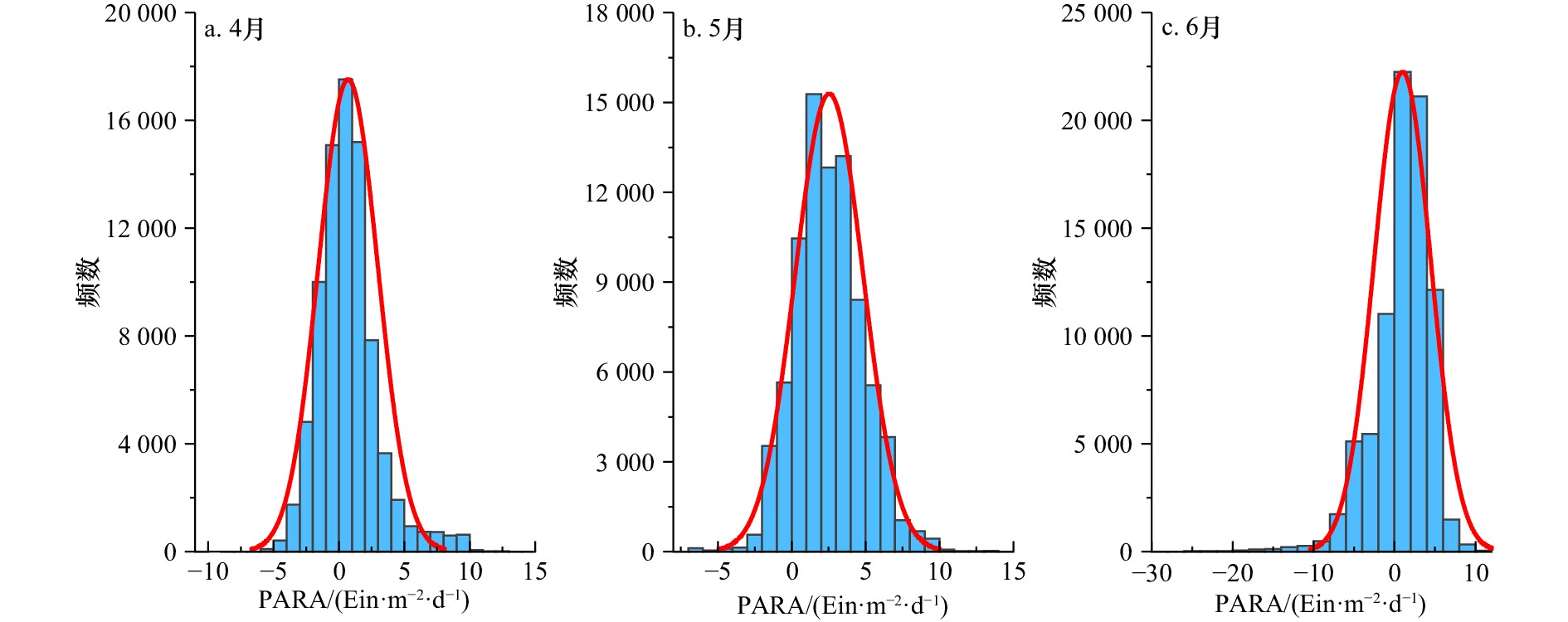Remote sensing monitoring and temporal and spatial distribution characteristics of gold tide in the South Yellow Sea
-
摘要: 近年来海洋生态灾害频发,大量漂浮藻类聚集在海面和近岸海域,给沿岸城市的经济活动和生态健康带来了严重危害。本研究利用HY-1C、GF-1和HJ-1A/1B卫星遥感影像对南黄海海域2016–2020年4–6月份的马尾藻进行了信息提取和生长阶段的划分,并通过MODIS海温数据、光合有效辐射数据和海面风场数据来探究环境因子对马尾藻时空分布的影响。结果表明:(1)从时间上看马尾藻集中在每年的4–6月份暴发,2017年马尾藻的影响范围最大,其余年份较小;从空间上看马尾藻最早在长江入海口东北部远海被监测到,在35°~36°N附近海域消失;(2)从生长速率上看,马尾藻的生长阶段可以划分为“发展–暴发–消亡”3个阶段;(3)在不同的生长阶段,海水温度和光合有效辐射对马尾藻具有不同程度的影响,较高的海表温度和光合有效辐射导致2017年面积高于往年;在东南风的作用下,马尾藻呈从东南向西北漂移的趋势,这说明了马尾藻的时空特征受到多种环境因子的影响。Abstract: The marine ecological disasters occurred frequently in recent years. A large number of floating algae gather in the sea surface and inshore water, which brings serious harm to the economic activities and ecological health of coastal cities. In this study, HY-1C, GF-1 and HJ-1A/1B satellite remote sensing images were used to extract information and divide the growth stages of Sargassum in the South Yellow Sea from April to June in 2016 to 2020, combined with the MODIS sea surface temperature data, photosynthetically active radiation data and sea surface wind data to explore the effects of environmental factors on the temporal and spatial distribution of Sargassum. The results show that: (1) In terms of time, the Sargassum mainly appeared from April to June every year. Sargassum had the largest range of influence in 2017 and smaller in other years. In terms of space, the Sargassum was first detected in the far sea northeast of the Changjiang River Estuary and disappeared in the sea near 35°−36°N. (2) In terms of growth rate, the growth phase of Sargassum could be divided into three stages: “development-outbreak-extinction”. (3) At different growth stages, sea surface temperature and photosynthetically active radiation had different degrees of influence on Sargassum. The larger area of Sargassum in 2017 was mainly influenced by higher sea surface temperature and photosynthetically active radiation. The southeast monsoon promoted the drift of Sargassum from the southeast to the northwest and north. This shows that the spatiotemporal characteristics of Sargassum are affected by a variety of environmental factors.
-
Key words:
- HY-1C satellite /
- VB-FAH /
- Sargassum /
- sea surface temperature /
- photosynthetically active radiation /
- South Yellow Sea
-
表 1 HY-1C、GF-1和HJ-1A/1B卫星影像日期
Tab. 1 The image date of HY-1C, GF-1 and HJ-1A/1B satellite
HY-1C日期 HJ-1A/1B日期 GF-1日期 2016年 − 5月28日 5月11日,5月17日,5月19日,6月1日,6月13日 2017年 − 5月21日 4月29日,5月7日,5月1日,5月14日,5月18日,5月27日,6月9日 2018年 − 5月25日,5月31日 4月28日,5月10日,5月14日,5月23日 2019年 5月7日,5月23日 5月16日 5月3日,5月31日,6月3日 2020年 5月15日,5月18日,6月8日 − 4月24日,6月3日 注:−代表无数据。 -
[1] Gower J, Young E, King S. Satellite images suggest a new Sargassum source region in 2011[J]. Remote Sensing Letters, 2013, 4(8): 764−773. doi: 10.1080/2150704X.2013.796433 [2] 吴孟泉, 郭浩, 张安定, 等. 2008年−2012年山东半岛海域浒苔时空分布特征研究[J]. 光谱学与光谱分析, 2014, 34(5): 1312−1318. doi: 10.3964/j.issn.1000-0593(2014)05-1312-07Wu Mengquan, Guo Hao, Zhang Anding, et al. Research on the characteristics of Ulva. Prolifera in Shandong Peninsula during 2008−2012 based on MODIS data[J]. Spectroscopy and Spectral Analysis, 2014, 34(5): 1312−1318. doi: 10.3964/j.issn.1000-0593(2014)05-1312-07 [3] 张广宗, 吴孟泉, 孙晓, 等. 南黄海浒苔漂移轨迹年际变化规律及驱动因素[J]. 海洋与湖沼, 2018, 49(5): 1084−1093. doi: 10.11693/hyhz20180400093Zhang Guangzong, Wu Mengquan, Sun Xiao, et al. The Inter-annual drift and driven force of Ulva prolifera bloom in the Southern Yellow Sea[J]. Oceanologia et Limnologia Sinica, 2018, 49(5): 1084−1093. doi: 10.11693/hyhz20180400093 [4] Yuan Chunying, Yang Shuo, Wang Yue, et al. Effect of temperature on the growth and biochemical composition of Sargassum muticum[J]. Advanced Materials Research, 2014, 989−994: 747−750. doi: 10.4028/www.scientific.net/AMR.989-994.747 [5] Smetacek V, Zingone A. Green and golden seaweed tides on the rise[J]. Nature, 2013, 504(7478): 84−88. doi: 10.1038/nature12860 [6] Liu Jinlin, Xia Jing, Zhuang Minmin, et al. Golden seaweed tides accumulated in Pyropia aquaculture areas are becoming a normal phenomenon in the Yellow Sea of China[J]. Science of the Total Environment, 2021, 774: 145726. doi: 10.1016/j.scitotenv.2021.145726 [7] Sudhakar K, Mamat R, Samykano M, et al. An overview of marine macroalgae as bioresource[J]. Renewable and Sustainable Energy Reviews, 2018, 91: 165−179. doi: 10.1016/j.rser.2018.03.100 [8] Chen Yanlong, Wan Jianhua, Zhang Jie, et al. Spatial-temporal distribution of golden tide based on high-resolution satellite remote sensing in the South Yellow Sea[J]. Journal of Coastal Research, 2019, 90(SI): 221−227. [9] Cuevas E, Uribe-Martínez A, de los Ángeles Liceaga-Correa M. A satellite remote-sensing multi-index approach to discriminate pelagic Sargassum in the waters of the Yucatan Peninsula, Mexico[J]. International Journal of Remote Sensing, 2018, 39(11): 3608−3627. doi: 10.1080/01431161.2018.1447162 [10] Gower J F R, King S A. Distribution of floating Sargassum in the Gulf of Mexico and the Atlantic Ocean mapped using MERIS[J]. International Journal of Remote Sensing, 2011, 32(7): 1917−1929. doi: 10.1080/01431161003639660 [11] Xing Qianguo, Guo Ruihong, Wu Lingling, et al. High-resolution satellite observations of a new hazard of golden tides caused by floating Sargassum in winter in the Yellow Sea[J]. IEEE Geoscience and Remote Sensing Letters, 2017, 14(10): 1815−1819. doi: 10.1109/LGRS.2017.2737079 [12] Xiao Jie, Fan Shiliang, Wang Zongling, et al. Decadal characteristics of the floating Ulva and Sargassum in the Subei Shoal, Yellow Sea[J]. Acta Oceanologica Sinica, 2020, 39(10): 1−10. doi: 10.1007/s13131-020-1655-4 [13] 孔凡洲, 姜鹏, 魏传杰, 等. 2017年春、夏季黄海35°N共发的绿潮、金潮和赤潮[J]. 海洋与湖沼, 2018, 49(5): 1021−1030. doi: 10.11693/hyhz20180400082Kong Fanzhou, Jiang Peng, Wei Chuanjie, et al. Co-occurence of green tide, golden tide and red tides along the 35°N transect in the Yellow Sea during spring and summer in 2017[J]. Oceanologia et Limnologia Sinica, 2018, 49(5): 1021−1030. doi: 10.11693/hyhz20180400082 [14] 李雪娜, 韩震, 刘贤博, 等. 浒苔和马尾藻的生消与海表面温度的相互影响研究[J]. 海洋湖沼通报, 2016(5): 125−130.Li Xuena, Han Zhen, Liu Xianbo, et al. A study of the relationship between the processes of enteromorpha and sargassum and sea surface temperature[J]. Transactions of Oceanology and Limnology, 2016(5): 125−130. [15] 王宁, 曹丛华, 黄娟, 等. 浒苔和马尾藻遥感区分方法在业务监测中的应用研究[J]. 海洋预报, 2019, 36(4): 68−75. doi: 10.11737/j.issn.1003-0239.2019.04.009Wang Ning, Cao Conghua, Huang Juan, et al. Application research of enteromorpha and sargassum distinguishing method in operational monitoring[J]. Marine Forecasts, 2019, 36(4): 68−75. doi: 10.11737/j.issn.1003-0239.2019.04.009 [16] Sun Deyong, Chen Ying, Wang Shengqiang, et al. Using Landsat 8 OLI data to differentiate Sargassum and Ulva prolifera blooms in the South Yellow Sea[J]. International Journal of Applied Earth Observation and Geoinformation, 2021, 98: 102302. doi: 10.1016/j.jag.2021.102302 [17] 金松, 韩震, 刘瑜. 一种区分浒苔和马尾藻的遥感方法[J]. 遥感信息, 2016, 31(2): 44−48. doi: 10.3969/j.issn.1000-3177.2016.02.008Jin Song, Han Zhen, Liu Yu. A remote sensing method for discriminating Ulva prolifera and Sargassum[J]. Remote Sensing Information, 2016, 31(2): 44−48. doi: 10.3969/j.issn.1000-3177.2016.02.008 [18] 孙晓, 吴孟泉, 何福红, 等. 2015年黄海海域浒苔时空分布及台风“灿鸿”影响研究[J]. 遥感技术与应用, 2017, 32(5): 921−930.Sun Xiao, Wu Mengquan, He Fuhong, et al. Temporal and spatial distribution of Ulva. prolifera in the Yellow Sea and influence of typhoon “CHAN-HOM” in 2015[J]. Remote Sensing Technology and Application, 2017, 32(5): 921−930. [19] Sun Xiao, Wu Mengquan, Xing Qianguo, et al. Spatio-temporal patterns of Ulva prolifera blooms and the corresponding influence on chlorophyll-a concentration in the Southern Yellow Sea, China[J]. Science of the Total Environment, 2018, 640−641: 807−820. doi: 10.1016/j.scitotenv.2018.05.378 [20] Zhou Yuping, Tan Liju, Pang Qiuting, et al. Influence of nutrients pollution on the growth and organic matter output of Ulva prolifera in the southern Yellow Sea, China[J]. Marine Pollution Bulletin, 2015, 95(1): 107−114. doi: 10.1016/j.marpolbul.2015.04.034 [21] Zhang Haibo, Wang Guoshan, Zhang Chuansong, et al. Characterization of the development stages and roles of nutrients and other environmental factors in green tides in the Southern Yellow Sea, China[J]. Harmful Algae, 2020, 98: 101893. doi: 10.1016/j.hal.2020.101893 [22] Keesing J K, Liu Dongyan, Fearns P, et al. Inter-and intra-annual patterns of Ulva prolifera green tides in the Yellow Sea during 2007–2009, their origin and relationship to the expansion of coastal seaweed aquaculture in China[J]. Marine Pollution Bulletin, 2011, 62(6): 1169−1182. doi: 10.1016/j.marpolbul.2011.03.040 [23] Xu Fan, Tao Jianfeng, Zhou Zeng, et al. Mechanisms underlying the regional morphological differences between the northern and southern radial sand ridges along the Jiangsu Coast, China[J]. Marine Geology, 2016, 371: 1−17. doi: 10.1016/j.margeo.2015.10.019 [24] Zheng Longxiao, Wu Mengquan, Zhou Min, et al. Spatiotemporal distribution and influencing factors of Ulva prolifera and Sargassum and their coexistence in the South Yellow Sea, China[J]. Journal of Oceanology and Limnology, 2021, 40(3): 1070−1084. [25] Strong A E, McClain E P. Improved ocean surface temperatures from space—comparisons with drifting buoys[J]. Bulletin of the American Meteorological Society, 1984, 65(2): 138−142. doi: 10.1175/1520-0477(1984)065<0138:IOSTFS>2.0.CO;2 [26] Van Laake P E, Sanchez-Azofeifa G A. Simplified atmospheric radiative transfer modelling for estimating incident PAR using MODIS atmosphere products[J]. Remote Sensing of Environment, 2004, 91(1): 98−113. doi: 10.1016/j.rse.2004.03.002 [27] Van Laake P E, Sanchez-Azofeifa G A. Mapping PAR using MODIS atmosphere products[J]. Remote Sensing of Environment, 2005, 94(4): 554−563. doi: 10.1016/j.rse.2004.11.011 [28] 袁超, 张靖宇, 肖洁, 等. 基于哨兵2号卫星遥感影像的2018年苏北浅滩漂浮绿藻时空分布特征研究[J]. 海洋学报, 2020, 42(8): 12−20.Yuan Chao, Zhang Jingyu, Xiao Jie, et al. The spatial and temporal distribution of floating green algae in the Subei Shoal in 2018 retrieved by Sentinel-2 images[J]. Haiyang Xuebao, 2020, 42(8): 12−20. [29] Hu Chuanmin, Feng Lian, Hardy R F, et al. Spectral and spatial requirements of remote measurements of pelagic Sargassum macroalgae[J]. Remote Sensing of Environment, 2015, 167: 229−246. doi: 10.1016/j.rse.2015.05.022 [30] Xing Qianguo, Hu Chuanmin. Mapping macroalgal blooms in the Yellow Sea and East China Sea using HJ-1 and Landsat data: application of a virtual baseline reflectance height technique[J]. Remote sensing of Environment, 2016, 178: 113−126. doi: 10.1016/j.rse.2016.02.065 [31] Keesing J K, Liu Dongyan, Shi Yajun, et al. Abiotic factors influencing biomass accumulation of green tide causing Ulva spp. on Pyropia culture rafts in the Yellow Sea, China[J]. Marine Pollution Bulletin, 2016, 105(1): 88−97. doi: 10.1016/j.marpolbul.2016.02.051 [32] Zhang Jianheng, Kim J K, Yarish C, et al. The expansion of Ulva prolifera O. F. Müller macroalgal blooms in the Yellow Sea, PR China, through asexual reproduction[J]. Marine Pollution Bulletin, 2016, 104(1/2): 101−106. [33] Zhang Guangzong, Wu Mengquan, Zhang Anding, et al. Influence of sea surface temperature on outbreak of Ulva prolifera in the Southern Yellow Sea, China[J]. Chinese Geographical Science, 2020, 30(4): 631−642. doi: 10.1007/s11769-020-1129-9 [34] Song Wei, Peng Keqin, Xiao Jie, et al. Effects of temperature on the germination of green algae micro-propagules in coastal waters of the Subei Shoal, China[J]. Estuarine, Coastal and Shelf Science, 2015, 163: 63−68. doi: 10.1016/j.ecss.2014.08.007 [35] Graba-Landry A C, Loffler Z, McClure E C, et al. Impaired growth and survival of tropical macroalgae (Sargassum spp. ) at elevated temperatures[J]. Coral Reefs, 2020, 39(2): 475−486. doi: 10.1007/s00338-020-01909-7 [36] 伍玉梅, 徐兆礼, 樊伟, 等. 1985−2005年东海海表温度时空变化特征分析[J]. 海洋学报, 2011, 33(6): 9−18.Wu Yumei, Xu Zhaoli, Fan Wei, et al. Change of sea surface temperature in East China Sea during 1985−2005[J]. Haiyang Xuebao, 2011, 33(6): 9−18. [37] Wu Hailong, Feng Jingchi, Li Xinshu, et al. Effects of increased CO2 and temperature on the physiological characteristics of the golden tide blooming macroalgae Sargassum horneri in the Yellow Sea, China[J]. Marine Pollution Bulletin, 2019, 146: 639−644. doi: 10.1016/j.marpolbul.2019.07.025 [38] Gao Guang, Clare A S, Rose C, et al. Intrinsic and extrinsic control of reproduction in the green tide-forming alga, Ulva rigida[J]. Environmental and Experimental Botany, 2017, 139: 14−22. doi: 10.1016/j.envexpbot.2017.03.016 [39] Kim J, Park J H, Lee T H. Sensitivity analysis of steel buildings subjected to column loss[J]. Engineering Structures, 2011, 33(2): 421−432. doi: 10.1016/j.engstruct.2010.10.025 [40] Xing Qianguo, Hu Chuanmin, Tang Danling, et al. World’s largest macroalgal blooms altered phytoplankton biomass in summer in the Yellow Sea: satellite observations[J]. Remote Sensing, 2015, 7(9): 12297−12313. doi: 10.3390/rs70912297 [41] Qiao Fangli, Wang Guansuo, Lü Xingang, et al. Drift characteristics of green macroalgae in the Yellow Sea in 2008 and 2010[J]. Chinese Science Bulletin, 2011, 56(21): 2236−2242. doi: 10.1007/s11434-011-4551-7 -




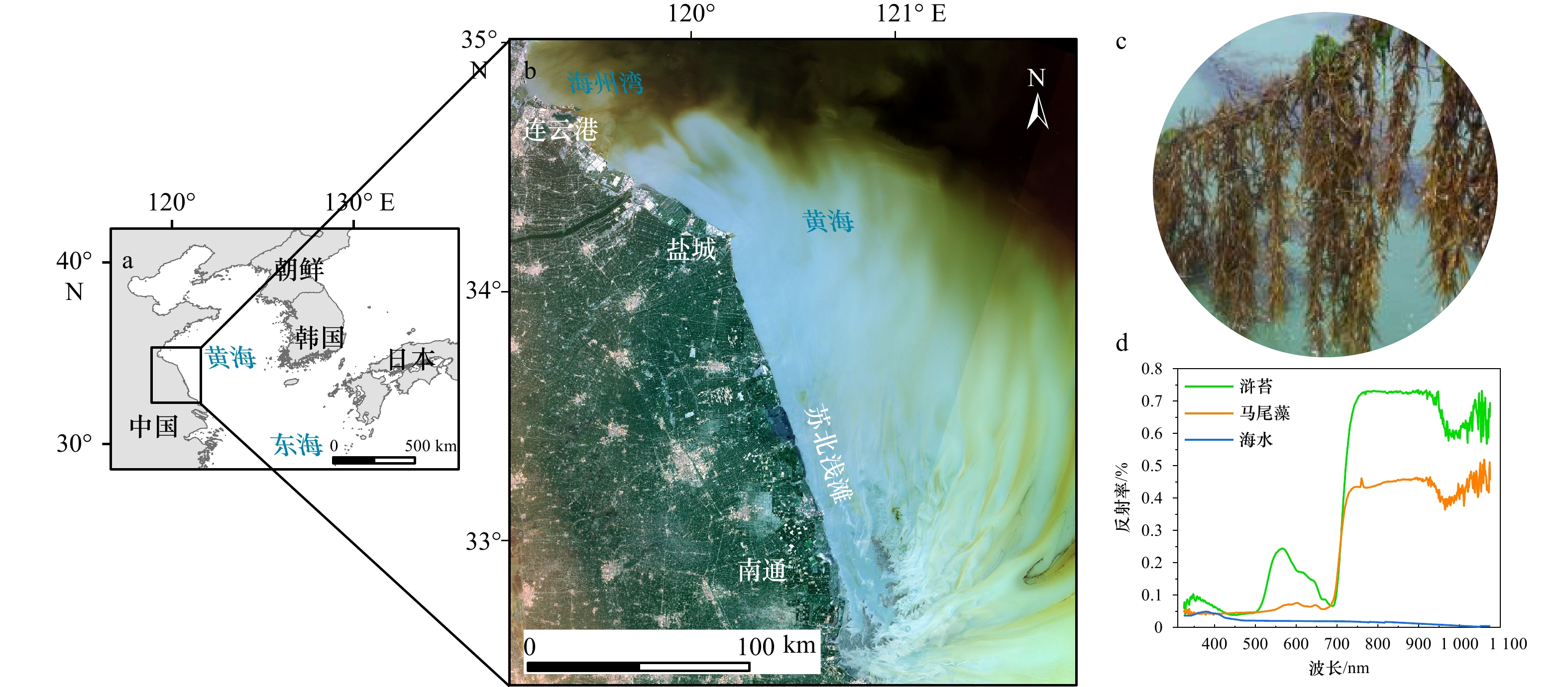
 下载:
下载:
